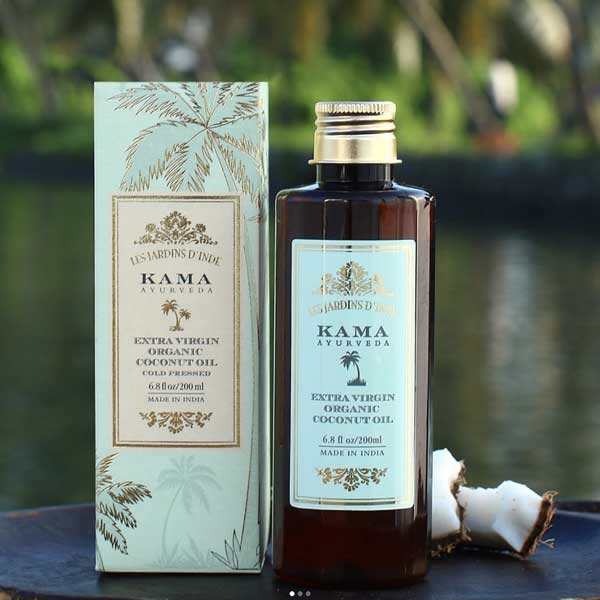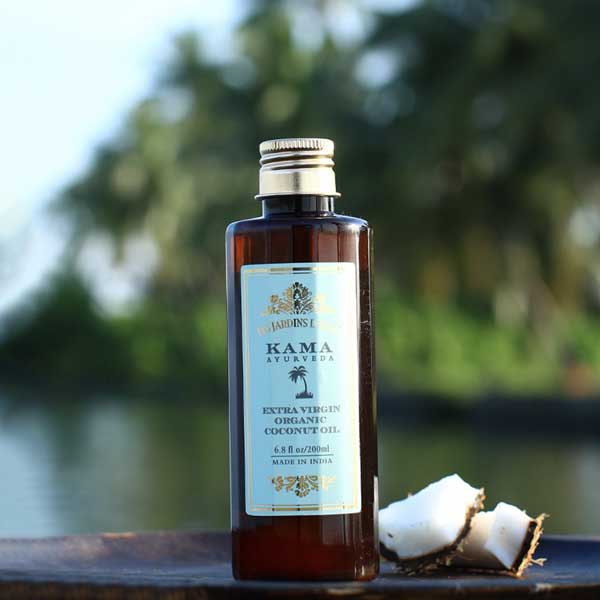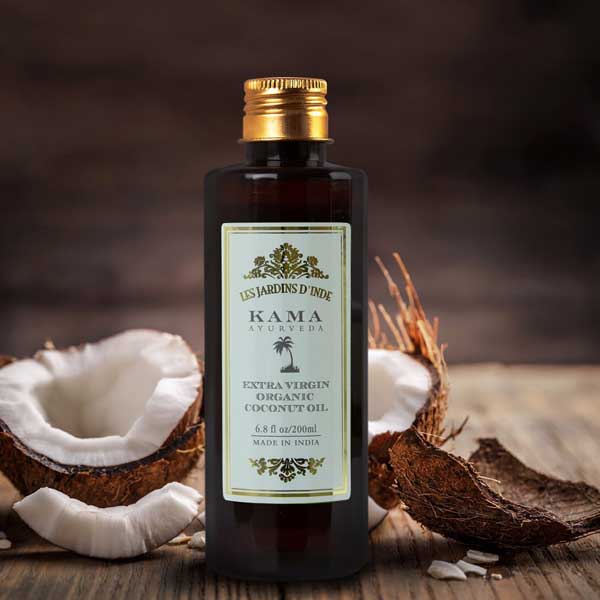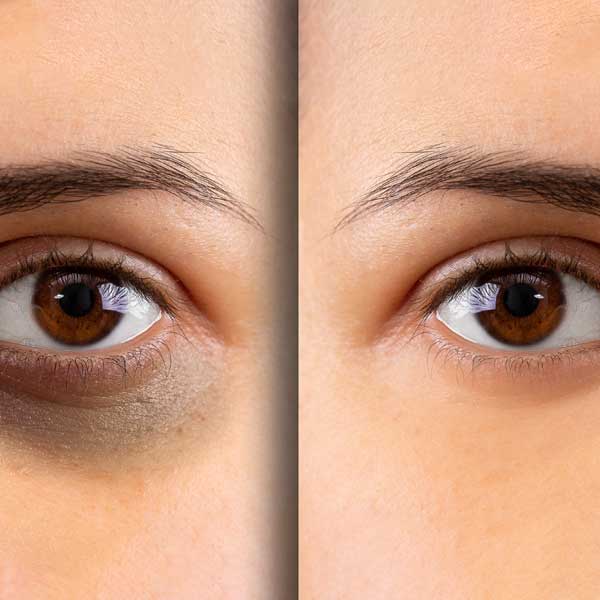In the sun-kissed regions of Southeast Asia and the Pacific Islands, there’s a secret to radiant skin that has been whispered from one generation to the next - Coconut oil.
Rich in Vitamin E, a potent skin-repairing antioxidant, and lauric acid, known for its anti-inflammatory properties, coconut oil is a time tested natural remedy for dark circles.
In this article, let’s understand how to use coconut oil to get rid of dark circles.

Why Use Coconut Oil For Dark Circles?
Dark circles often tell tales of fatigue, stress, or simply genetics. Let's uncover the reasons behind coconut oil's popularity as a remedy for those pesky under-eye patches.
1. Rich in Beneficial Fatty Acids:
Coconut oil is packed with small-chain fatty acids that are known to reduce inflammation and improve circulation. These properties can be particularly beneficial for the delicate skin under the eyes, which is prone to puffiness and discoloration.
2. Natural Moisturizer:
One of the primary causes of dark circles is dehydration. Coconut oil acts as a natural moisturizer, hydrating the skin and preventing it from drying out. Its emollient properties ensure that the skin remains soft and supple.
3. Skin Strengthening:
As we age, the skin under our eyes becomes thinner, making the blood vessels more visible and leading to the appearance of dark circles. Coconut oil has skin-strengthening qualities, which can potentially thicken the skin barrier, making these blood vessels less prominent.
4. Antioxidant Properties:
The oxidative stress caused by free radicals can exacerbate skin problems, including dark circles. Coconut oil possesses antioxidant properties that combat these free radicals, promoting healthier skin.
5. Promotes Cell Turnover:
Some studies suggest that coconut oil can expedite cell regeneration. This means that the application of coconut oil can lead to the faster replacement of damaged skin cells with new ones, potentially reducing the appearance of dark circles over time.
6. Safe and Natural:
In a world where many skincare products are laden with chemicals, coconut oil offers a natural alternative. While it's always essential to conduct a patch test to rule out allergies, coconut oil is generally considered safe for topical application.
7. Cost-Effective:
High-end under-eye creams and treatments can be expensive. Coconut oil, on the other hand, is a cost-effective solution that offers multiple benefits, not just for dark circles but for overall skin health

How To Use Coconut Oil For Dark Circles
To maximize its potential and ensure the best results, follow this step-by-step guide to using Coconut Oil for dark circles:
Choose the Right Coconut Oil:
Opt for cold-pressed, virgin coconut oil. This type retains the most nutrients as it hasn't been exposed to high temperatures or chemicals during processing. It's often labeled as "virgin" or "extra virgin."
Preparation:
Gently cleanse your face to remove any makeup, dirt, or impurities. Pay special attention to the under-eye area, ensuring it's free from any residual makeup or creams.
Pat your face dry with a soft towel, taking care not to rub or pull the delicate skin under the eyes.
Application:
Scoop out a small amount of coconut oil with your fingertip. Remember, a little goes a long way. Next, warm the oil between your fingers to liquefy it, making it easier to apply.
Gently dab and massage the oil onto the dark circles. Use soft, patting motions to encourage absorption without stretching the skin.
Avoid getting the oil directly into your eyes. If it does enter, rinse your eyes with water immediately.
Optimal Timing:
The best time to apply coconut oil is before bedtime. This allows the oil to work its magic overnight, deeply nourishing the skin while you sleep.
If you choose to apply it during the day, wait a few minutes to let the oil absorb before applying any makeup or sunscreen.
Consistency is Key:
For noticeable results, make this a regular part of your skincare routine. Apply coconut oil daily or at least several times a week.
DIY Treatments:
Enhance the benefits by combining coconut oil with other natural ingredients. For instance, a mixture of coconut oil and turmeric can offer added skin-lightening properties, while blending with almond oil can provide extra hydration.
Safety First:
While coconut oil is generally safe for topical use, it's essential to conduct a patch test before extensive application. Apply a small amount on your wrist or behind the ear and wait for 24 hours to check for any allergic reactions.
What Causes Dark Circles?
Did you know that dark circles aren’t simply caused by a lack of sleep. There are many factors that could result in those under-eye shadows.
Understanding the root causes of dark circles is the first step in addressing and treating them effectively. Let’s understand a few of them -
- Aging: As we age, our skin becomes thinner, especially around the eyes. This thinning makes the blood vessels beneath the skin more visible, leading to the appearance of dark circles.
- Fatigue: Lack of sleep or excessive tiredness can cause the skin to become pale, making blood vessels more prominent and the area beneath the eyes darker.
- Genetics: Dark circles can run in families. If your parents or grandparents had them, you might be more predisposed to having them too.
- Eye Strain: Staring at screens (computers, TVs, phones) for prolonged periods can strain the eyes, causing blood vessels around them to enlarge and darken the surrounding skin.
- Allergies: Allergic reactions can lead to increased blood flow to the area beneath the eyes, causing them to appear darker.
- Dehydration: Insufficient water intake can make the skin under the eyes appear dull and the eyes sunken, creating shadows.
- Sun Exposure: Overexposure to the sun can prompt the body to produce more melanin, the pigment responsible for skin color, leading to pigmentation in the under-eye area.
DIY treatments with Coconut Oil using Dark Circles
Coconut oil, with its nourishing and moisturizing properties, can be combined with various natural ingredients to create effective DIY treatments for dark circles. Here are some popular recipes:
1. Coconut Oil and Turmeric:
- Ingredients: A pinch of turmeric powder and a teaspoon of coconut oil.
- Method: Mix the two ingredients to form a paste. Apply it gently under the eyes and let it sit for about 10 minutes before rinsing off. Turmeric has anti-inflammatory properties and can help lighten the skin.
2. Coconut Oil and Almond Oil:
- Ingredients: Equal parts of coconut oil and almond oil.
- Method: Blend the oils and apply the mixture under the eyes before bedtime. Almond oil is an effective remedy for dark circles, also known for its skin-lightening properties and ability to reduce puffiness.
3. Coconut Oil and Vitamin E:
- Ingredients: A few drops of vitamin E oil and a teaspoon of coconut oil.
- Method: Mix and apply under the eyes. Vitamin E is an antioxidant that can help repair damaged skin cells and improve skin elasticity.
4. Coconut Oil and Aloe Vera:
- Ingredients: A teaspoon of coconut oil and a teaspoon of aloe vera gel.
- Method: Blend the ingredients and apply to the under-eye area. Aloe vera is soothing and can help reduce inflammation and puffiness.
5. Coconut Oil and Cucumber:
- Ingredients: A few cucumber slices and a teaspoon of coconut oil.
- Method: First, place the cucumber slices on your eyes for about 10 minutes. After removing them, massage the coconut oil gently into the skin. Cucumbers have a cooling effect and can help reduce swelling.
6. Coconut Oil and Green Tea:
- Ingredients: A used green tea bag and a teaspoon of coconut oil.
- Method: After steeping your green tea, allow the tea bag to cool. Place it on your eyes for about 10 minutes. Once removed, apply coconut oil to the area. Green tea contains antioxidants that can help reduce puffiness and dark circles.
Remember, before trying any DIY treatment, it's essential to conduct a patch test to ensure you don't have any allergic reactions to the ingredients. Also, consistency is key, so apply these treatments regularly for the best results.
Potential Side Effects of Using Coconut oil For Dark Circles
Using coconut oil for dark circles is generally considered safe for most people, especially when applied topically. However, as with any skincare product, there can be potential side effects. Here are some to be aware of:
- Skin Irritation: Some individuals might experience redness, itching, or a burning sensation after applying coconut oil. This could be a sign of an allergic reaction or sensitivity to the oil.
- Acne Breakouts: Coconut oil is comedogenic, meaning it can clog pores. For those with acne-prone or oily skin, using coconut oil might lead to breakouts or exacerbate existing acne.
- Milium Cysts: These are tiny, white bumps that can form on the skin when keratin gets trapped under the skin's surface. While not directly linked to coconut oil, heavy oils or creams can sometimes contribute to their formation, especially around the delicate eye area.
- Eye Irritation: If coconut oil gets into the eyes, it can cause temporary blurriness or a stinging sensation. It's essential to apply the oil carefully to avoid direct contact with the eyes.
- Worsening of Dark Circles: In rare cases, if an individual is allergic or sensitive to coconut oil, the skin's reaction might darken the under-eye area further.
- Ineffectiveness: For some, coconut oil might simply not work in reducing dark circles, especially if the circles' primary causes are genetic or due to bone structure.
It's always a good idea to conduct a patch test before using coconut oil extensively, especially in sensitive areas like under the eyes. If any adverse reactions occur, it's advisable to discontinue use and consult a dermatologist or healthcare professional.

How Effective Is Coconut Oil For Dark Circles As Per Research?
While coconut oil holds promise as a potential remedy for dark circles due to its skin-beneficial properties, more targeted research is needed to establish its definitive effectiveness. Here’s what current research tells us about its impact -
Traditional Use and Anecdotal Evidence:
Coconut oil's use as a skin moisturizer and healer dates back to ancient civilizations, especially in tropical regions. Many individuals swear by its benefits for reducing dark circles based on personal experiences and traditional practices.
Skin-Nourishing Properties:
Scientifically, coconut oil is known to be rich in medium-chain fatty acids, which have moisturizing properties. It also contains antioxidants and anti-inflammatory compounds, which can benefit the skin. These properties suggest that coconut oil can hydrate the under-eye area, reduce inflammation, and potentially lighten dark circles.
Limited Direct Research:
While there's ample research on coconut oil's benefits for skin health, direct studies focusing on its effectiveness for dark circles are limited. Most evidence is anecdotal, and results can vary from person to person.
Cell Regeneration and Repair:
Some studies suggest that coconut oil can promote wound healing and collagen production. Enhanced collagen production can potentially thicken the skin under the eyes, making blood vessels less visible and thereby reducing the appearance of dark circles.
Safety and Tolerance:
Research indicates that virgin coconut oil is generally safe for topical application and is well-tolerated by most individuals. However, as with any skincare product, reactions can occur, especially in those with sensitive skin.
Comparison with Other Treatments:
While coconut oil offers a natural and cost-effective approach, there are other treatments like chemical peels, laser therapy, and specialized under-eye creams that have undergone more extensive research for dark circle reduction. The effectiveness of coconut oil compared to these treatments remains a topic of debate.
Conclusion
In conclusion, while coconut oil holds promise as a potential remedy for dark circles, individual results may vary. It's essential to approach its use with an open mind and realistic expectations. If dark circles persist or worsen, consulting a dermatologist or skincare specialist is advisable.

